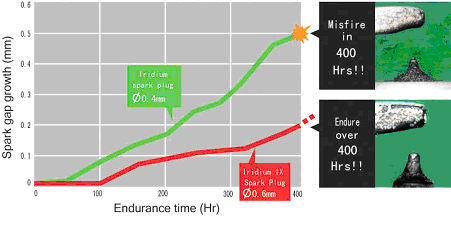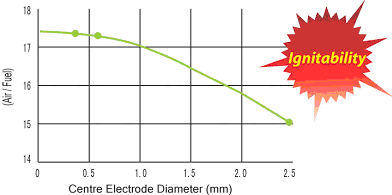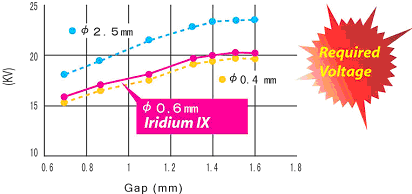
Technical Bulletins
NGK IRIDIUM IX SPARK PLUGS
Iridium is a precious metal that has the advantage of a higher melting point than platinum and is also more durable. These advantages combined with NGK's patented designs have produced a spark plug that offers performance gains previously not available.
At the request of vehicle manufacturers, NGK have developed a range of Iridium spark plugs with centre electrode diameters as small as 0.4mm. It's a known fact that the finer the centre electrode the better the spark plug performance. However, testing has shown that it is possible to go too small and introduce practical drawbacks that hinder performance of a plug over its service life. Prior to the release of the Iridium IX spark plugs, NGK conducted extensive testing and development and made the decision to manufacture the aftermarket IX range with a centre electrode diameter of 0.6mm. The rationale behind this is explained below.
1. Durability
Durability is determined by the rate at which the spark gap grows. The service
life of a spark plug ends when the electrode gap is too large and misfire
occurs. To compare durability, tests were conducted with 0.6mm & 0.4mm diameter
electrodes in a 2.5L engine simulating high speeds for 400 hours continuous
driving. The results of this test show the smaller diameter electrode having
much greater gap growth over the 400 hours. The reason is that sparks jumping
from the 0.4mmØ centre electrode erode away a smaller surface area on the ground
electrode resulting in more rapid gap growth. Sparks jumping from the 0.6mmØ
centre electrode wear the ground electrode more evenly resulting in not only a
longer service life but performance being maintained over the full life of the
plug.
| Fig 1. |
 |
2. Ignitability
Ignitability is a measure of how effectively and efficiently a spark plug can
ignite the air fuel mixture. There are numerous ways in which ignitability can
be quantified - one popular method is to lean out the air/fuel mixture until
misfire occurs. Since lean mixtures are difficult to ignite, it follows that
spark plugs that can ignite leaner mixtures have better ignitability
characteristics which enables them to perform better under normal operation. The
result is increased power and efficiency from each combustion cycle. Spark plugs
with smaller centre electrode diameter (CED) offer better ignitability results.
Reducing the CED of a spark plug, reduces what is commonly referred to as the
quenching effect (that is heat energy loss from hot flame kernel to cooler
electrodes as the flame attempts to expand and combust the mixture).
A standard spark plug's centre electrode of 2.5mm diameter has more than 15 times the surface area of a 0.6mm CED Iridium spark plug. Moving from a standard plug to an NGK Iridium results in a dramatic improvement in ignitability as can be seen in the test results in Figure 2. However, there is a limit to improving on ignitability by reducing the CED of a spark plug. NGK test results indicate that the performance curve begins to flatten past 0.6mm, which means there is a negligible improvement in ignitability realised by further reductions in the CED. This negligible improvement in ignitability does not compensate the subsequent loss in service life suffered by the 0.4mm CED plug.
| Fig 2. |
 |
3. Required Voltage
Fine centre electrodes offer the advantage of a reduction in required voltage. With fine centre electrodes, the electric field is concentrated across a smaller surface area with sparking able to occur at a lower voltage. The required voltage of a 2.5mm, 0.6mm and 0.4mm centre electrode plugs is shown in Fig 3 where for each plug the gap was manually adjusted and required voltage measured. There is a considerable reduction in required voltage across all gap lengths, when moving from a Ø2.5mm plug to Ø0.6mm or Ø0.4mm. However, there is only a marginal improvement in required voltage between the Ø0.6mm and Ø0.4mm spark plugs. These results were conducted on brand new plugs. Given that the Ø0.4mm Iridium plugs are not as durable as their Ø0.6mm counterparts, means that they will have a greater rate of gap growth and increase in required voltage as they wear.
| Fig 3. |
 |
4. 0.6mm OR 0.4mm?
NGK Spark Plugs manufactures both 0.6mm and 0.4mm Iridium spark plugs at the request of vehicle manufacturers. For the performance market, NGK have made the decision to offer only the Ø0.6mm Iridium IX spark plug. This decision was based on the above (and other) test results and observations conducted over a long period of time. The NGK Iridium IX spark plugs with 0.6mm CED offer superior performance over their full service life. Their solid durability and ability to maintain excellent levels of performance allow the NGK Iridium IX plugs to outperform any other spark plug in the market.